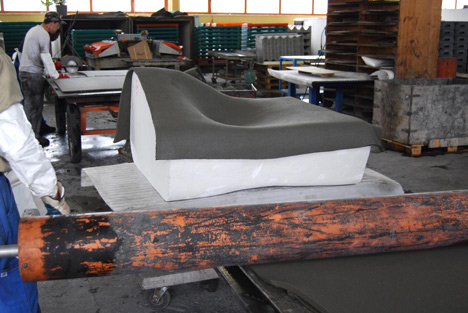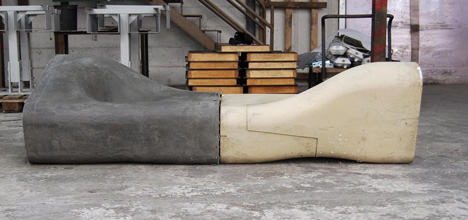If you're in Copenhagen, do come by the Danish Architecture Centre next Wednesday Dec 8th, 2010.
Along with two great speakers I've been invited to talk about building materials of the future - which of course in my case would be fabric formwork.
The talks are in Danish, I'm afraid - but feature three different approaches to working with material futures - besides my own which is the low tech approach yet new combination of materials known for millennia, two other architects are these:
Mette Ramsgaard Thomsen who was just appointed Professor at the RDAFA, is the head of CITA and a leading figure in the practice lead discourse of digital practice.
Kasper Guldager Jørgensen is head of development at Danish Architecture studio 3XN. He's really into features of emerging material technologies and how to embed them in the architectural practice of the firm.
Monday, November 29, 2010
Lecturing at the Danish Architecture Centre
Labels:
3XN,
CITA,
DAC,
fabric formwork,
Lecture,
Royal Danish Academy of Fine Arts
Friday, November 26, 2010
Smokin' Concrete Hotpants
Swedish innovator and company Butong has added another project to the portfolio since Cancer City that I wrote about here. The translucent character of the technology is exploited in a project executed with White Architects.
Titled ‘Hot Pants Smokin’, referring to the song by James Brown, this sculpture of concrete and light was executed by White Arkitekter and Butong for the biannual Uppsala Lighting Festival (a.k.a. Allt Ljus på Uppsala).
The architects inform us on the project:
"Uppsala is situated in northern Europe, as far north as Alaska or Greenland. Through the dark month of november this glimmering structure stands in one of the busiest shopping streets of the swedish city.
[Two smoke machines regularily emit smoke which help to catch the light in the air. The result is a 3,5 meter high sculpture that may remind of a pair of glittering disco pants, a starry gate or a space-age Stone Henge]
[‘This is a lighting festival. But as architects we wanted to explore form and material containing light, rather than focusing on the lighting equipment’, says Jacob Melin]
The architects inform us on the project:
"Uppsala is situated in northern Europe, as far north as Alaska or Greenland. Through the dark month of november this glimmering structure stands in one of the busiest shopping streets of the swedish city.
‘This is a lighting festival. But as architects we wanted to explore form and material containing light, rather than focusing on the lighting equipment’, says Jacob Melin.
‘We wanted to make a mysterious and archaic object, in some ways contrasting to the commercial and mundane part of the city where it stands’.
How the Hotpants were made:
The material used is translucent concrete from Butong, mounted into 48 unique frames of thin steel profile.
This low-tech BIM-project was developed working with physical models using steel rods joined by small magnetic balls.
The rods were then numbered and measured, and L-profiles were cut ten times their lengths and welded into triangles.
Each sheet of butong was cut into shape with a knife in it’s wet state before being fixed in place in its frame.
The filled triangles were then welded together into five boxes, lights were installed and finally the structure was screwed together on the site.
Daniel Ljung took care of the design of the lighting and Philips sponsored with luminaires.
Smoke on the dance floor
Two smoke machines regularily emit smoke which help to catch the light in the air. The result is a 3,5 meter high sculpture that may remind of a pair of glittering disco pants, a starry gate or a space-age Stone Henge. It is placed in a pedestrian street, and it’s legs seem to be caught in the middle of a step.
Architecture can be interactive without buttons to press. Some choose to walk through, while others circle. Kids stop to peek inside, or pierce new and bigger holes in the structure where the concrete is paper-thin, letting more light out from the inside.
‘We choose to leave the crusts without protective layer, letting the sculpture transform throughout the month’, says Lars Höglund.
CONTRIBUTORS AND INFO:
Architect: Jacob Melin of White arkitekter
Construction and co-design: Lars Höglund and J-C Violleau of Butong
Location: S:t Persgatan, Uppsala, Sweden.
Lighting: Daniel Ljung
Event: Uppsala Lighting Festival 2010
Client: Uppsala City and Uppsala Kommun
Photographs: Per Lundström
links:
www.butong.se
www.white.se
www.alltljuspauppsala.se
Construction and co-design: Lars Höglund and J-C Violleau of Butong
Location: S:t Persgatan, Uppsala, Sweden.
Lighting: Daniel Ljung
Event: Uppsala Lighting Festival 2010
Client: Uppsala City and Uppsala Kommun
Photographs: Per Lundström
links:
www.butong.se
www.white.se
www.alltljuspauppsala.se
Labels:
Butong,
Design,
White Arkitekter
Fabric formwork - and Concretely in print
The editor-in-chief of the Danish Concrete trade magazine called "Beton", Jan Broch Nielsen, is always very supportive in covering the workshops that I do. A full two pages made it to the latest issue of the magazine, #4- 2010
[The cover of the 4/2010 of Danish Concrete Trade magazine "Beton" (Concrete), image from website]
The headline of the article introduces this very blog to the readers of the magazine. Readers, to a high degree, work in the concrete industry on plants, or on construction sites as concrete workers, engineers etc. - If the article actually brings forth a new reader - welcome :)
The article mentions Butong as an example of the content of the blog. The post about Butong is here. And here's a more recent project.
[Image from fabric formwork workshop, Photo by: Balazs Jelinek]
Material culture workshop
Two thirds of the article is about the student workshop held with European architecture students in August, 2010, in the Danish island of Bornholm. I wrote about the pour day here.
Above image from the Erasmus summer school illustrates the article. The image shows to groups of students finishing the fabric formwork before the big pour that same morning. Unfortunately, the photographer wasn't credited. Balazs Jelinek took the picture.
Labels:
Bornholm,
Butong,
fabric formwork,
Material Culture,
publication,
workshop
Sunday, November 21, 2010
Fabric Formwork in World Architecture Magazine
Just a little show off :) Here's a link to a publication that I wrote an article to.
The SHL website informs:
"The theme is Sustainable Development through Holistic Design. -
The special issue of World Architecture focuses on how schmidt hammer lassen architects practises sustainable design. The featured projects in different scales, from macro to micro perspective, are for example Ecobay Masterplan in Tallinn, Estonia; Tian Yi Town Masterplan in Wuxi, China; Wuhan Great Lake Project in Hubei, China; The Crystal in Copenhagen, Denmark; City of Westminster College in London, U.K.; and Groendalsvej Zero-Energy Office Building in Aarhus, Denmark. schmidt hammer lassen architects has worked in China since 2003 and now has more than 10 completed projects.
With contributions from Chinese, Danish, British, and Swedish experts, scholars and architects, this special issue offers a broad introduction to the design philosophy and architecture of schmidt hammer lassen architects."
and
"World Architecture is China’s leading architectural magazine with a circulation of 30,000. The magazine, which was established in 1980, is sponsored by Tsinghua University."
[The front cover of World Architecture]
The Danish architect office schmidt hammer lassen Architects is part of my thesis work about fabric formwork for concrete. When the Chinese architecture magazine World Architecture did a special issue about the office I contributed with an article about sustainable aspects of fabric forming.The SHL website informs:
"The theme is Sustainable Development through Holistic Design. -
The special issue of World Architecture focuses on how schmidt hammer lassen architects practises sustainable design. The featured projects in different scales, from macro to micro perspective, are for example Ecobay Masterplan in Tallinn, Estonia; Tian Yi Town Masterplan in Wuxi, China; Wuhan Great Lake Project in Hubei, China; The Crystal in Copenhagen, Denmark; City of Westminster College in London, U.K.; and Groendalsvej Zero-Energy Office Building in Aarhus, Denmark. schmidt hammer lassen architects has worked in China since 2003 and now has more than 10 completed projects.
With contributions from Chinese, Danish, British, and Swedish experts, scholars and architects, this special issue offers a broad introduction to the design philosophy and architecture of schmidt hammer lassen architects."
and
"World Architecture is China’s leading architectural magazine with a circulation of 30,000. The magazine, which was established in 1980, is sponsored by Tsinghua University."
Labels:
China,
fabric formwork,
publication,
shl
Wednesday, November 17, 2010
Eternit chairs explores production
I enjoy the curious look by Rainer Mutsch into the production facilities at Viennese composite concrete company Eternit. Eternit is the commercial name for fibre reinforced concrete normally used as flat facade panels.
Rainer Mutsch (1977) is the recent designer who've added to the range of design products produced along with the weather boards.
[Video of the production process]
Loop Chair - the forefather
If you think the design looks familiar you probably recall the forefather of Eternit Chairs - Mutsch's design is indeed inspired by Swiss Willy Guhl who designed the iconic 1954 Loop Chair - still in production by Eternit.
Mutsch quotes Guhl (1915-2004) who said:
“there is no ‚good’ or ‚bad’ material, what makes the difference is its right and adequate use.”
Rainer Mutsch (1977) is the recent designer who've added to the range of design products produced along with the weather boards.
[Image of the three modular types in the Dune series, from Mutsch's website]
Mutsch informs on the background:
When I saw the very first Eternit – machine, I was amazed: 20 metres long, more than 100 years old and by now of course upgraded with high-tech computers, the very heart of the machine is still the cast-metal construction built back in 1905. This impressive device survived 2 world wars and is until today producing a material which is sold worldwide.
[The shell and the mold, photo from Dezeen]
[Video of the production process]
Loop Chair - the forefather
If you think the design looks familiar you probably recall the forefather of Eternit Chairs - Mutsch's design is indeed inspired by Swiss Willy Guhl who designed the iconic 1954 Loop Chair - still in production by Eternit.
[Image of Loop Chair, by Willy Guhl, 1954]
Mutsch quotes Guhl (1915-2004) who said:
“there is no ‚good’ or ‚bad’ material, what makes the difference is its right and adequate use.”
Labels:
Chairs,
Design,
Eternit,
Rainer Mutsch
Subscribe to:
Comments (Atom)
















